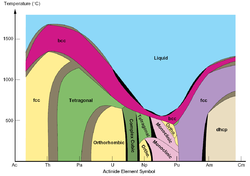
Allotropy
Background to the schools Wikipedia
This Schools selection was originally chosen by SOS Children for schools in the developing world without internet access. It is available as a intranet download. Do you want to know about sponsoring? See www.sponsorachild.org.uk
Allotropy is the property of some chemical elements to be able to take two or more different forms, where the atoms are arranged differently by chemical bonds. The forms are known as allotropes of that element. The phenomenon of allotropy is sometimes also called allotropism. For example, carbon has two common allotropes: diamond, where the carbon atoms are bonded together in a tetrahedral lattice arrangement, and graphite, where the carbon atoms are bonded together in sheets of a hexagonal lattice.
The word allotropy comes from the Greek allos, meaning "other", and tropos, "manner".
Allotropy refers only to different forms of an element within the same phase or state of matter (i.e. different solid, liquid or gas forms). Changes of state (between solid, liquid and gas) are not considered allotropy. Some elements have allotropes that persist in different phases - for example, the two allotropes of oxygen ( dioxygen, O2, and ozone, O3), can both exist in the solid, liquid and gaseous states. Other elements maintain distinct allotropes only in some phases - for example phosphorus has many solid allotropes, which all revert to the same P4 form when melted to the liquid state.
History
The concept of allotropy was originally proposed in 1841 by the Swedish scientist Baron Jons Jakob Berzelius (1779-1848) who offered no explanation. After the acceptance of Avogadro's hypothesis in 1860 it was understood that elements could exist as polyatomic molecules, and the two allotropes of oxygen were recognized as O2 and O3. In the early 20th century it was recognized that other cases such as carbon were due to differences in crystal structure.
By 1912, Ostwald noted that the allotropy of elements is just a special case of the phenomenon of polymorphism known for compounds, and proposed that the terms allotrope and allotropy be abandoned and replaced by polymorph and polymorphism. Although many other chemists have repeated this advice, IUPAC and most chemistry texts still favour the usage of allotrope and allotropy for elements only.
Differences in properties of an element's allotropes
Allotropes are different structural forms of the same element and can exhibit quite different physical properties and chemical behaviours. The change between allotropic forms is triggered by the same forces that affect other structures, i.e. pressure, light, and temperature. Therefore the stability of the particular allotropes depends on particular conditions. For instance, iron changes from a body-centered cubic structure (ferrite) to a face-centered cubic structure ( austenite) above 906 °C, and tin undergoes a transformation known as tin pest from a metallic phase to a semiconductor phase below 13.2 °C.
List of allotropes
Typically, elements capable of variable coordination number and/or oxidation states tend to exhibit greater numbers of allotropic forms. Another contributing factor is the ability of an element to catenate. Allotropes are typically more noticeable in non-metals and metalloids. Nevertheless, metals tend to have many allotropes.
Examples of allotropes include:
Non-metals
Carbon:
- diamond - an extremely hard, transparent crystal, with the carbon atoms arranged in a tetrahedral lattice. A poor electrical conductor. An excellent thermal conductor.
- graphite - a soft, black, flaky solid, a moderate electrical conductor. The C atoms are bonded in flat hexagonal lattices, which are then layered in sheets.
- amorphous carbon
- fullerenes, including " buckyballs", such as C60, and carbon nanotubes
Phosphorus:
- White phosphorus - crystalline solid P4
- Red phosphorus - polymeric solid
- Scarlet phosphorus
- Violet phosphorus
- Black phosphorus - semiconductor, analogous to graphite
- Diphosphorus
Oxygen:
- dioxygen, O2 - colorless
- ozone, O3 - blue
- tetraoxygen, O4 - metastable
- octaoxygen, O8 - red
- dinitrogen
- tetranitrogen
- trinitrogen
- two solid forms: one hexagonal close-packed and the other alpha cubic
Sulfur:
- Plastic (amorphous) sulfur - polymeric solid
- Rhombic sulfur - large crystals composed of S8 molecules
- Monoclinic sulfur - fine needle-like crystals
- Other ring molecules such as S7 and S12
- "Red selenium," cyclo-Se8
- Gray selenium, polymeric Se
- Black selenium
Metalloids
- amorphous boron - brown powder
- crystalline boron - black, hard (9.3 on Mohs' scale), and a weak conductor at room temperature.
- amorphous silicon - brown powder
- nanocrystalline silicon - similar to the amorphous silicon
- crystalline silicon - has a metallic luster and a grayish colour. Single crystals of crystalline silicon can be grown with a process known as the Czochralski process
- Yellow arsenic - molecular non-metallic As4
- Gray arsenic, polymeric As (metalloid)
- Black arsenic (metalloid) and several similar other ones.
- blue-white antimony - the stable form (metalloid)
- yellow antimony (non-metallic)
- black antimony (non-metallic)
- (a fourth one too)
Polonium has two metallic allotropes.
Metals
- grey tin (alpha-tin)
- white tin (beta tin)
- rhombic tin (gamma)
Iron
- ferrite (alpha iron) - forms below 770°C (the Curie point, Tc ); the iron becomes magnetic in its alpha form; BCC
- beta - forms below 912°C (BCC)
- gamma - forms below 1401°C; face centred cubic (FCC) crystal structure
- delta - forms from cooling down molten iron below 1535°C; has a body-centred cubic (BCC) crystal structure
Titanium has two allotropes
Strontium has three allotropes
Lantanides and actinides
- Plutonium has six distinct solid allotropes under "normal" pressures. Their densities vary within a ratio of some 4:3, which vastly complicates all kinds of work with the metal (particularly casting, machining, and storage). A seventh plutonium allotrope exists at very high pressures, which adds further difficulties in exotic applications.
- Ytterbium has three allotropes
- Terbium has two crystalline allotropes
- Promethium has two allotropic forms
- Curium has 3 allotropes (also Americium, Berkelium, Californium do)



